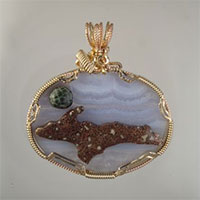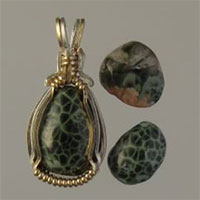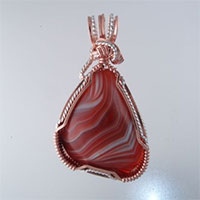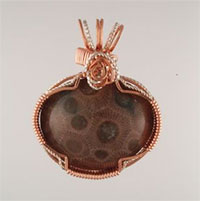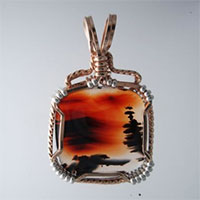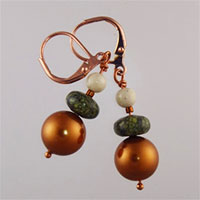One of my recent Facebook Posts about Fordite generated some questions about the safety of handling and/or cutting potentially hazardous Rocks and Minerals. Old Fordite contains lead.
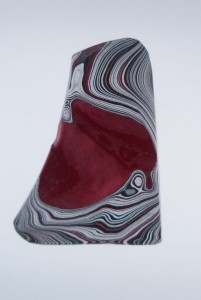
This Fordite looks like candy, but don't eat it.
We here in Michigan have been known to “lick” our rocks (don’t say you haven’t done this also). In NW lower Michigan the Calcite Fossils, Quartz’s, and Igneous glacial till is fairly docile and the pattern is much more prominent when moist.
While hunting in Utah with local expert rockhounds, we were told, “Do not lick the rocks here like you do in Michigan”. It was explained that many western rocks contain Copper (Cu), Lead (Pb), Arsenic (As), Mercury (Hg), and other things you should not put into your body. A great article I found through a Google is at: http://wildaboutrocks.com/Articles-Show-Reports/Toxic-Minerals
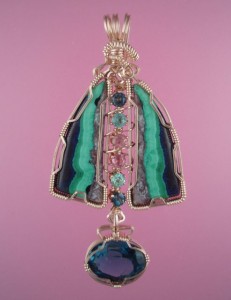
Azurite/Malachite makes beautiful jewelry, but is one of the gemstones we should be cautious cutting.
Those that collect rocks and minerals are exposed to hazardous specimens all the time. Mercury-containing minerals like Cinnabar or Realgar are two that come to mine, but other minerals that we lapidary-types come in contact with are generally fairly docile, but release hazardous materials when cut.
Fordite is paint layers that formed in paint booths from overspray. Much was laid down in the 60’s +/- and contained lead. Years ago we were not as aware of exposure to this mineral, but today we know, and are cognizant of the hazards of exposure to certain minerals.
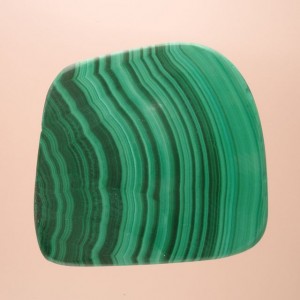
Malachite, wonderful stuff but contains copper.
In general ANY Mineral that contains the aforementioned Minerals, as well as others can be potentially harmful. Michigan Minerals from the Copper Country are of particular concern. Any copper related mineral like Chrysocolla, Cuprite, or in particular Mohawkite should be cut with caution. Mohawkite is a Silver-Copper-Arsenate found in the mine waste piles in the central Keweenaw. I wait until my saws are ready to be cleaned out before slicing Mohawkite, then dispose of the saw oil in a safe manner.
Whenever I cut one of the minerals containing a hazardous mineral I always use loads of water, mask, and rubber gloves. Malachite is one stone that really concerned me is that many people just cut without any protection. If a tart, metallic taste is detected, or if you can taste any rock dust, be concerned and take action. Every time I see all the cut Malachite in Tucson I think of how many poor, unaware Africans are being poisoned making this stuff.
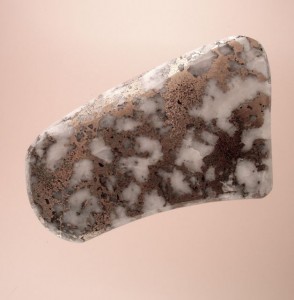
Mohawkite is a Silver/Copper/Arsenate. After I cut my cabs, I seal them in Industrial Epoxy. I do this so they do not tarnish, but it also seals in anything that may be hazardous.
Most of the hazardous gemstones can safely be worn in jewelry with little or no concern.
The bottom line is; ALWAYS be aware of what you are cutting. Try not to inhale the spray generated in cutting (even Quartz-Silica dust should not be induced into you lungs). Be safe in your shop. The internet is a great place to check on the hazards of rocks and minerals. Check the chemical makeup of the rocks you are working with. If the rock contains any of the minerals I’ve mentioned earlier, be wary.
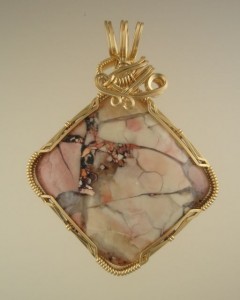
Tiffany Stone (Betrandite). I named the pendant "X marks the spot".
I haven’t even mentioned the radioactive minerals. In general, we do not use those minerals in jewelry making.( wait; my wife mentioned Tiffany Stone) Tiffany Stone is an Opalite material from Utah that contains the radioactive mineral Beryllium. The percentage of Beryllium in Tiffany Stone is so small it is considered not to be of a concern.
I am going to also post this up for my Facebook friends. This short blog is only a start for this discussion. Feel free to add your comments and suggestions. I know I left things out. I’ve only had one cup of coffee so far.


